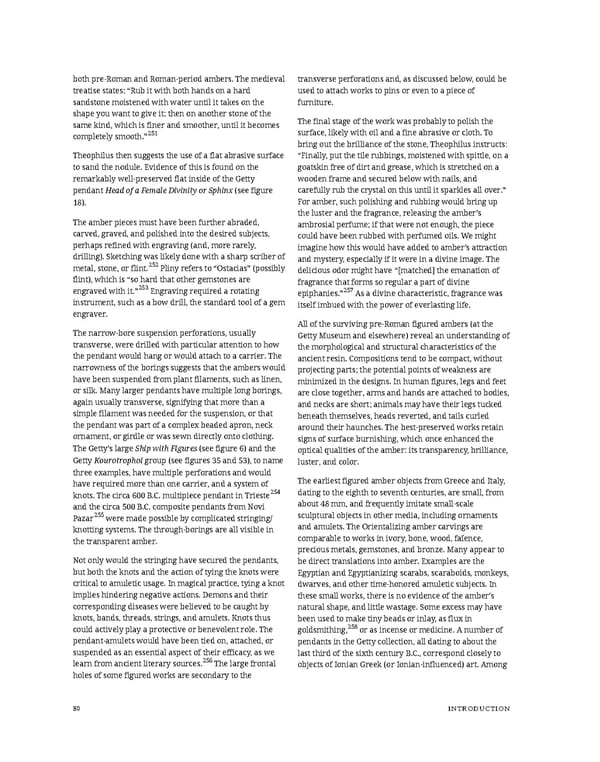both pre-Roman and Roman-period ambers. The medieval transverse perforations and, as discussed below, could be treatise states: “Rub it with both hands on a hard used to attach works to pins or even to a piece of sandstone moistened with water until it takes on the furniture. shape you want to give it; then on another stone of the same kind, which is finer and smoother, until it becomes The final stage of the work was probably to polish the completely smooth.”251 surface, likely with oil and a fine abrasive or cloth. To bring out the brilliance of the stone, Theophilus instructs: Theophilus then suggests the use of a flat abrasive surface “Finally, put the tile rubbings, moistened with spittle, on a to sand the nodule. Evidence of this is found on the goatskin free of dirt and grease, which is stretched on a remarkably well-preserved flat inside of the Getty wooden frame and secured below with nails, and pendantHead of a Female Divinity or Sphinx (see figure carefully rub the crystal on this until it sparkles all over.” 18). For amber, such polishing and rubbing would bring up the luster and the fragrance, releasing the amber’s The amber pieces must have been further abraded, ambrosial perfume; if that were not enough, the piece carved, graved, and polished into the desired subjects, could have been rubbed with perfumed oils. We might perhaps refined with engraving (and, more rarely, imagine how this would have added to amber’s attraction drilling). Sketching was likely done with a sharp scriber of and mystery, especially if it were in a divine image. The metal, stone, or flint.252 Pliny refers to “Ostacias” (possibly delicious odor might have “[matched] the emanation of flint), which is “so hard that other gemstones are fragrance that forms so regular a part of divine engraved with it.”253 Engraving required a rotating epiphanies.”257 As a divine characteristic, fragrance was instrument, such as a bow drill, the standard tool of a gem itself imbued with the power of everlasting life. engraver. All of the surviving pre-Roman figured ambers (at the The narrow-bore suspension perforations, usually Getty Museum and elsewhere) reveal an understanding of transverse, were drilled with particular attention to how the morphological and structural characteristics of the the pendant would hang or would attach to a carrier. The ancient resin. Compositions tend to be compact, without narrowness of the borings suggests that the ambers would projecting parts; the potential points of weakness are have been suspended from plant filaments, such as linen, minimized in the designs. In human figures, legs and feet or silk. Many larger pendants have multiple long borings, are close together, arms and hands are attached to bodies, again usually transverse, signifying that more than a and necks are short; animals may have their legs tucked simple filament was needed for the suspension, or that beneath themselves, heads reverted, and tails curled the pendant was part of a complex beaded apron, neck around their haunches. The best-preserved works retain ornament, or girdle or was sewn directly onto clothing. signs of surface burnishing, which once enhanced the The Getty’s large Ship with Figures (see figure 6) and the optical qualities of the amber: its transparency, brilliance, Getty Kourotrophoi group (see figures 35 and 53), to name luster, and color. three examples, have multiple perforations and would have required more than one carrier, and a system of The earliest figured amber objects from Greece and Italy, knots. The circa 600 B.C. multipiece pendant in Trieste254 dating to the eighth to seventh centuries, are small, from and the circa 500 B.C. composite pendants from Novi about 48 mm, and frequently imitate small-scale Pazar255 were made possible by complicated stringing/ sculptural objects in other media, including ornaments knotting systems. The through-borings are all visible in and amulets. The Orientalizing amber carvings are the transparent amber. comparable to works in ivory, bone, wood, faïence, precious metals, gemstones, and bronze. Many appear to Not only would the stringing have secured the pendants, be direct translations into amber. Examples are the but both the knots and the action of tying the knots were Egyptian and Egyptianizing scarabs, scaraboids, monkeys, critical to amuletic usage. In magical practice, tying a knot dwarves, and other time-honored amuletic subjects. In implies hindering negative actions. Demons and their these small works, there is no evidence of the amber’s corresponding diseases were believed to be caught by natural shape, and little wastage. Some excess may have knots, bands, threads, strings, and amulets. Knots thus been used to make tiny beads or inlay, as flux in could actively play a protective or benevolent role. The goldsmithing,258 or as incense or medicine. A number of pendant-amulets would have been tied on, attached, or pendants in the Getty collection, all dating to about the suspended as an essential aspect of their efficacy, as we last third of the sixth century B.C., correspond closely to learn from ancient literary sources.256 The large frontal objects of Ionian Greek (or Ionian-influenced) art. Among holes of some figured works are secondary to the 80 INTRODUCTION
 Ancient Carved Ambers in the J. Paul Getty Museum Page 89 Page 91
Ancient Carved Ambers in the J. Paul Getty Museum Page 89 Page 91